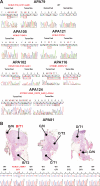Novel somatic mutations in primary hyperaldosteronism are related to the clinical, radiological and pathological phenotype
- PMID: 26252618
- PMCID: PMC4995792
- DOI: 10.1111/cen.12873
Novel somatic mutations in primary hyperaldosteronism are related to the clinical, radiological and pathological phenotype
Abstract
Aldosterone-producing adenomas (APAs) and bilateral adrenal hyperplasia are important causes of secondary hypertension. Somatic mutations in KCNJ5, CACNA1D, ATP1A1, ATP2B3 and CTNNB1 have been described in APAs.
Objective: To characterize clinical-pathological features in APAs and unilateral adrenal hyperplasia, and correlate them with genotypes.
Design: Retrospective study.
Subjects and measurements: Clinical and pathological characteristics of 90 APAs and seven diffusely or focally hyperplastic adrenal glands were reviewed, and samples were examined for mutations in known disease genes by Sanger or exome sequencing.
Results: Mutation frequencies were as follows: KCNJ5, 37·1%; CACNA1D, 10·3%; ATP1A1, 8·2%; ATP2B3, 3·1%; and CTNNB1, 2·1%. Previously unidentified mutations included I157K, F154C and two insertions (I150_G151insM and I144_E145insAI) in KCNJ5, all close to the selectivity filter, V426G_V427Q_A428_L433del in ATP2B3 and A39Efs*3 in CTNNB1. Mutations in KCNJ5 were associated with female and other mutations with male gender (P = 0·007). On computed tomography, KCNJ5-mutant tumours displayed significantly greater diameter (P = 0·023), calculated area (P = 0·002) and lower precontrast Hounsfield units (P = 0·0002) vs tumours with mutations in other genes. Accordingly, KCNJ5-mutant tumours were predominantly comprised of lipid-rich fasciculata-like clear cells, whereas other tumours were heterogeneous (P = 5 × 10(-6) vs non-KCNJ5 mutant and P = 0·0003 vs wild-type tumours, respectively). CACNA1D mutations were present in two samples with hyperplasia without adenoma.
Conclusions: KCNJ5-mutant tumours appear to be associated with fasciculata-like clear cell predominant histology and tend to be larger with a characteristic imaging phenotype. Novel somatic KCNJ5 variants likely cause adenomas by loss of potassium selectivity, similar to previously described mutations.
© 2015 John Wiley & Sons Ltd.
Figures



References
-
- Rossi GP, Bernini G, Caliumi C, et al. A prospective study of the prevalence of primary aldosteronism in 1,125 hypertensive patients. Journal of the American College of Cardiology. 2006;48:2293–2300. - PubMed
-
- Funder JW, Carey RM, Fardella C, et al. Case detection, diagnosis, and treatment of patients with primary aldosteronism: an endocrine society clinical practice guideline. Journal of Clinical Endocrinology and Metabolism. 2008;93:3266–3281. - PubMed
-
- Mosso L, Carvajal C, Gonzalez A, et al. Primary aldosteronism and hypertensive disease. Hypertension. 2003;42:161–165. - PubMed
-
- Milliez P, Girerd X, Plouin PF, et al. Evidence for an increased rate of cardiovascular events in patients with primary aldosteronism. Journal of the American College of Cardiology. 2005;45:1243–1248. - PubMed
-
- Young WF. Primary aldosteronism: renaissance of a syndrome. Clinical Endocrinology. 2007;66:607–618. - PubMed
Publication types
MeSH terms
Substances
Grants and funding
LinkOut - more resources
Full Text Sources
Other Literature Sources
Miscellaneous

